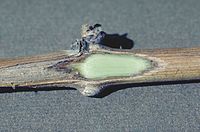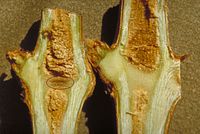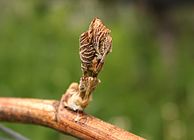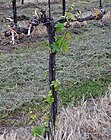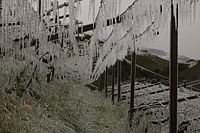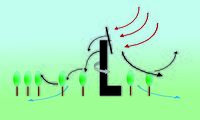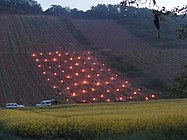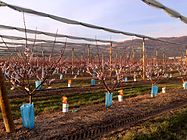Frost damage (viticulture)
Frost can cause damage to the vine both during the growing season and when it is dormant. The risk depends on various factors depending on the area and location. While diseases and pests can be combated effectively and economically efficiently, countermeasures in the event of extreme weather conditions, including frost, are much more expensive. This applies in particular to late frost damage, which can occur more frequently in a continental climate due to climate change.
The extent of damage depends on many factors, in particular the duration of the frost, the humidity, the stage of development of the vine and the grape variety. The occurrence of frost in a vineyard site is therefore a limiting location factor .
A frost location is a location that, due to its topography, is more frequently at risk than average from frost. This can be both early frosts (in late autumn), winter frosts or late frosts (spring). Mostly these layers are in depressions, valleys or at the foot of the slope, where the air flow z. B. is obstructed by railway embankments, road embankments or hedges and cold air lakes can form. Frosty locations require a targeted selection of grape varieties and later increased workload (loss of sticks, frost protection measures).
Early frost
One speaks of early frost when green leaves are damaged by temperatures below 0 ° C before the end of the vegetation period or before the end of the fall of leaves. Green parts of the vines freeze to death at temperatures just below 0 ° C. Grape varieties show differences in sensitivity. So the z. B. The leaves of the Scheurebe variety are more resistant to early frost damage than other grape varieties. The leaves turn reddish brown and curl up. The leaf falls prematurely. This prevents photosynthesis, making a further increase in must weight and storage of reserves more difficult. Unripe berries turn reddish brown in color and take on a frosty taste. Fully ripe grapes, on the other hand, do not harm frost.
There is a risk of early frost in valleys where the cold air collects in the form of cold air lakes. If the grape ripeness is already very advanced, there are only minor disadvantages for the grapes and vines in terms of wood ripeness.
Winter frost
Winter frost damage occurs through inter- or intracellular ice formation and thus damage to cells in the vines. Decisive for the severity of the damage is not only the depth of the temperature, but also the course of the weather before and after exposure to the cold, the time, the cooling rate, duration of frost, thawing speed, soil properties and the nutritional and developmental condition (stage of development, variety, clone, age , Previous year's yield, plant protection measures, soil care, fertilization) of the vine. In well-ripened vines, the critical temperature is around –20 ° C. Winter frost is tolerated very differently by the varieties. Slowly falling temperatures are less dangerous than a sudden cold snap. It is particularly dangerous for the vine when the frost is preceded by a mild weather period.
Frost hardiness, frost resistance
This is mainly promoted by the withdrawal of water and the ability or speed of the conversion of starch into low molecular weight sugar. The vine reaches its greatest resistance to winter frost from late December to mid-February. This then decreases and the variety differences also decrease. As soon as the flow of sap begins in the ducts, the risk of frost increases significantly. Late winter frosts at this time are very dangerous for all varieties and the extent of damage is usually very high.
Vines with insufficient storage of reserve materials are particularly at risk of winter frost. The nutrient potassium is of great importance for the water balance and photosynthesis. A lack of potassium not only reduces the quality of the grapes, but also the resistance to winter frost. Young vines and very old vines in particular are affected by this, due to insufficient fertilization and disease. The winter frost resistance of varieties is known from many years of experience.
| low | medium | high |
|---|---|---|
| White wine varieties | ||
| Silvaner, Huxelrebe, Scheurebe, Roter Veltliner, Goldburger, Neuburger, Jubiläumsrebe, Müller-Thurgau, Frühroter Veltliner, Rotgipfler, Sauvignon Blanc, Zierfandler, Reichensteiner | Ruländer, Weißer Burgunder, Chardonnay, Silvaner, Muskateller, Grüner Veltliner, Welschriesling, Bouvier, Furmint, Traminer, Cabernet Blanc, Johanniter, Souvignier Gris | Riesling, Kerner, Muskat Ottonel, Bianca, Bronner, Muscaris, Donauriesling, Blossom Muscat |
| Red wine varieties | ||
| Blauer Portugieser, Blauburger, Merlot, Blauer Kardaka, Syrah | Blauer Burgunder, Blaufränkisch, St. Laurent, Zweigelt, Blauer Wildbacher, Cabernet Sauvignon, Cabernet Franc | Roesler, Rathay, Regent, Cabernet Jura |
- American vine rootstocks tolerate down to −25 ° C, Vitis Riparia down to −40 ° C.
Symptoms of Harm
Diaphragm (wooden bridge) and cambium damage
If the diaphragm freezes to death, reserves are lost and when the shoots are bent after pruning, they break off more easily. Both the bast, cambium and wood part in annual wood can be damaged. If the cambium is damaged, there is no increase in thickness in this area. Damage of this kind often only becomes apparent after a few months due to sudden death of parts of the vine or the entire vine. Young vines that have only little reserve material stored are more often affected. Depending on the ripeness and type of wood, damage can occur from around -10 ° C.
Eye damage (bud damage)
Completely frozen eyes do not sprout in spring (stay seated). Inside the eyes, all the shoots are colored black. If only the main drive system is frozen, this manifests itself in a somewhat delayed emergence of the secondary eyes (secondary drive systems). Various methods can be used to get an overview of the extent of damage. Damage to the cambium can be recognized by cutting. The bast and cambial tissue is discolored gray to black-brown when damaged. Such shoots should not be used to build up the cane and as noble rice for propagation. This makes it impossible for the refining partners to grow together. Therefore, the vines must be cut in the vineyard in good time for propagation (end of November to December) to avoid damage and thus loss of growth.
Determination of the severity of the frost damage
The determination may only be carried out after the frost period has subsided.
- By longitudinal cut (finishing knife) through the eyes in the lower to middle shoot area, which are usually cut.
- A more precise picture of the eye losses can be obtained with one-eye cuttings - inserted through a 1 cm thick foam sheet drilled through - in water (swimming method) at 20 or better at 25 ° C. Budding begins after about 14 days.
- Setting noble rice rods (10 eyes) in water at room temperature only results in poor budding values.
An eye loss of up to approx. 30% is not to be classified as damage, as this percentage of eye loss can also be achieved under normal conditions.
Old wood
In the case of very severe winter frost, the annual and perennial wood can also be completely or partially damaged. This damage shows up in spring when the trunk opens. So-called frost cracks arise when the damaged trunk area dries out. Sticks that have been so badly damaged can be rebuilt with these if there is sufficient development of water shoots above the refinement point. Slight damage only becomes apparent after months (yellowing of the foliage) or a few years due to sudden death ( apoplexy ) of the vines - mostly as a result of excessive yield strain. This slight frost damage is often the cause of the occurrence of wound and weakness parasites (Eutypa, Esca, Uneven Holzbohrer). Heavy frost is also the trigger for muck. Infected ( Agrobacterium vitis ) vines are often caused to die by the cancerous growths.
Severe winter frost damage occurs when the vines have started to flow in sap. At this time, the frost resistance drops significantly and the damage can be considerable for all varieties (without differences).
Prevention or damage reduction
Before new installation:
- Location, choice of variety: Avoid known frost locations when creating a vineyard. When choosing the variety, consider the variety's sensitivity to frost.
- Education system: Choosing an education system with higher tribes also enables late frost damage to be reduced. → see also: Vine training
- When to plant: In endangered locations, do not plan to plant until after the ice saints (mid-May), or pile up after planting. The cover with earth gives protection.
Existing systems:
- Frost rods: In existing vineyards, frost rods (frost reserves) can be cut in frosty locations. Some time after all eyes on the vine have sprouted, the frost rods are removed, partially or completely left.
- Pile up: Pile up the lower trunk area in autumn in all deep and therefore frost-prone locations. Young plants should generally be piled up in autumn.
- Late pruning: The more frost-prone the location, the later the pruning should take place or after the main frost period, as uncut vines are somewhat more resistant.
- Buried: In wine-growing areas with very low winter temperatures, the whole vines are buried to protect them against winter frost. → see also: Vine training
Late frost in spring
During the budding phase, the vine is particularly sensitive to late frost. Green shoot parts, especially near the ground, freeze to death from approx. –1 to –2 ° C. Shoot parts and tendons initially become limp, soon brown-black and dry up. Buds that sprout are dark brown inside and do not sprout. Young vines are particularly at risk (even in the planting year); Total failure is possible with freshly planted vines. After the frost event, the vines are shocked and new shoots begin after about 14 days.
Influence from climate change
With climate change , the likelihood of warmer winters and thus of earlier bud sprouting increases. The shoots are therefore more often exposed to the risk of a possible late frost. Phenological records show that the vines were sprouting earlier and earlier. This extends the period of time in which late frosts can cause damage. For example, in Franconia this time has been extended by two to three weeks.
Causes of late frosts
Radiant frost due to inversion weather
Radiation frost occurs when the temperature falls below 0 ° C as a result of a negative long-wave radiation balance during the night. Late frosts occur above all when an inversion weather situation develops under the influence of high pressure with no wind . Normally, the air close to the ground is warmer than the layers above, but this is reversed in cold, clear, frosty nights. Without a protective cloud cover, the warm air rising from the ground can escape upwards. At the same time, cold air flows from the high altitude into the valley. This creates the inversion stratification, in which the temperatures are very cold near the ground, but significantly warmer air masses are located a few meters above the ground. In this situation there is no air exchange by wind because the cold and heavier air masses lie under lighter warm air layers. This leads to the dreaded late frost damage in depressions or reservoirs. Experience has shown that the minus temperatures occur in the early morning hours, between 3 and 7 a.m. (until just before sunrise).
Contributing factors for the occurrence of radiation frost are: long nights; a low heat capacity of the substrate; dry air; Little wind or calm (no mixing of the air layers).
Radiant frosts occur more frequently than wind frosts.
Wind frost (advection frost, current frost)
We speak of wind frost when frost occurs as a result of horizontal transport (advection) of a cold air mass with an air temperature below 0 ° C. Wind frosts can cause damage in any situation. Without inversion stratification, these cause frost damage which, depending on the direction of flow of the cold air wedge, can be found on all vineyards exposed to the wind. A number of frost prevention measures are ineffective when there is wind frost.
Contraceptive measures
Indirect action
* Soil tillage: Keep the soil open (do not till the soil in spring - tillage increases surface, soil cools down faster). Significantly shorten or mulch existing greenery before the probable frost event. This measure achieves a reduction in the heat-emitting floor surface. Even after using herbicides, the soil temperature is 0.25 - 0.5 ° C higher than after mulching or keeping the soil open.
* Pre-irrigation: A damp soil can store more heat (up to 30%) than a dry one. If the possibility exists, irrigation in advance can reduce the frost severity in dry soil. However, the irrigation must be carried out in good time so that the vines to be protected can still dry out. The overhead irrigation systems required for this are mostly hardly available in vineyards due to the lack of water. Drip irrigation only moistens part of the soil and is not as efficient at this.
* Cover with soil: In autumn, plowing (plowing) of the vines or late transplanting (from around mid-May) in locations at risk of frost.
* Frost rods: Frost rods can be cut to the normal level if late frost damage is expected. After the expulsion, the frost rods are removed when the expulsion is complete in order to achieve the intended cut thickness. For economic reasons, frost rods are only left in typical frost conditions. Frost rods should be cut long (higher number of eyes) so that the main eyes are initially inhibited in the budding process.
* Sprouting delay : Measures that delay sprouting can reduce the vine's susceptibility to late frost. A late pruning delays the shoot and allows a certain amount of damage to be corrected after a frost. In North America, "double pruning" (double pruning) is used in locations with a frequent risk of frost. This uses the apical dominance of the shoots. A cordon with short cones is a prerequisite for this. The shoots are only shortened to a length of 60 cm in winter. If the eyes that were first driven out at the end of the tail are damaged after a late frost event, the lower eyes near the trunk are used, which mostly have not yet driven out. This is intended to ensure that one main eye is driven out and thus avoid yield losses. After the danger of late frost, the second actual pruning takes place, in which the shoots are cut back to one or two eyes. Experience shows that budding is delayed by 20–30 days. This delay naturally has its after-effects in the entire development of the vine. Many years of experience are not yet available in Europe. Various chemical substances (antifreeze) are used to slow down bud emergence. Various oils are currently being tested.
* Education system: The education system can also reduce the damage caused by winter and late frosts. The greater the distance between the cut wood and the ground, the lower the risk. In minimal pruning systems, the risk of late frost is reduced due to the high number of eyes and the higher shoot zone.
* Frost insurance : In some countries, frost protection insurance for vineyards is offered by insurance companies.
Direct control options
Direct control options are: misting / smoking, covering, frost sprinkling, air mixing, heating. When used correctly, they offer more or less protection.
Weather forecasts and warning devices are helpful for effective late frost control. Accurate temperature measuring devices are necessary inside and outside the systems to be protected. Frost warning devices can only issue advance warnings.
- * Fogging / smoking: With timely burning of heavily smoking material you want to achieve a protective blanket of fog over the vineyards. Experience has shown that this method has little or no effectiveness. With a layer of fog, the heat radiation is to be reduced and after the frost, to prevent the sun from acting too quickly. Rapid thawing of frozen parts of plants after the frost increases the extent of damage. What can be theoretically explained cannot be implemented in practice. The more or less dense layer of fog produced consists mainly of smoke and less of water vapor. Less energy can be stored in the smoke and is therefore an insufficient heat buffer and cannot prevent the temperature from falling. The use of nebulization machines is also unsuitable for this. In addition, the purchase of a nebulization machine and its operation are associated with high costs. These measures to protect against late frost damage are ineffective.
- * Cover: With different cover materials over the vine or vine line. The frost protection effect is based on an inhibition of heat loss through radiation and / or convection. The effectiveness essentially depends on the impermeability of the material to thermal radiation and on the wind tightness. The differences are particularly large with plastic films. Polyethylene (PE) films allow heat rays to pass through almost unhindered, whereas polyvinyl chloride (PVC) films hold back the radiation. Aluminum-coated foils are also suitable. Not only do they absorb heat radiation, they also reflect it. Such films have to be removed again during the day because of their opacity. The method is very laborious and can therefore only be used on small areas. In the past, in the lower pile culture, the individual vines were covered with cardboard frost protection screens.
- * Antifreeze irrigation: A frost protection irrigation is subject to sufficient availability of water, a good antifreeze control method. The prerequisite, however, is that 2-4 leaves on the young shoots are already unfolded. In the case of frost protection sprinkling, the solidification heat of the water (80 kcal / kg = 332.5 kJ / kg water) is used (change in the physical state from liquid to solid). This protects the plant parts against freezing. Since the cold from evaporation (540 kcal / kg = 2257 kJ / kg water) is almost seven times as high as the heat of solidification, frost sprinkling cannot be used in wind frosts. It is very important that the irrigation system is already in operation before the critical temperature is reached. Especially when the dew point is well below the critical temperature. In order to continuously release thermal energy, water has to freeze permanently. Frost protection sprinkling shortly after the vines have sprouted is ineffective, as the surface to be protected is still too small to release the heat of solidification. Frost protection sprinkling offers protection down to approx. −6 ° C and in case of radiation frost (wind only up to a maximum of 1 m / s). With stronger winds, the heat losses through evaporation increase disproportionately. The irrigation is switched on at +1 ° C and switched off at +2 ° C when most of the ice has melted.
- An important requirement is a stationary slow irrigation system (3–4 mm precipitation / hour) and an adequate water supply during the frost period. The water requirement is very high. Approx. 30–40 m³ / ha are required per hour. If it has to be switched off during the frosty night due to lack of water, the damage is greater compared to non-irrigation.
* Air mixing: The air can be mixed using stationary or mobile wind machines or rotors (helicopters). Depending on the temperature difference between the air layers and their mixing, frost protection down to –1.5 ° C to –2 ° C can be achieved. In addition to the noise pollution, the disadvantage of wind machines is that the cold air from valley depressions is not fully blown. Another weak point are edge zones, where the effect decreases. Frost ovens or frost candles, which are set up in this area, provide a remedy.
- * Stationary Wind Machine : This machine is widely used in New Zealand and California. The wind machine swirls the warmer, higher air layer with the colder layer close to the ground. A propeller mixes the layers of air. Wind machines are about 12 meters high and have a propeller 6 m in diameter and an angle of attack of about 6 °. The propeller turns on its own axis every four minutes. Depending on the temperature difference, a temperature increase of up to 2 ° C can be achieved in the area of the vine when there is almost no wind. Stationary wind machines only protect against radiation frost. Protection area approx. 5 hectares at -2 ° C, approx. 1.5 hectares at -5 ° C.
- * Mobile wind machine: A mobile wind machine can cover approx. 3–4 ha at -2 ° C, approx. 1 ha at -5 ° C. A propeller at a mast height of 6 m mixes the layers of air. The mobile wind machine has a high power requirement, causes high levels of noise and is associated with high acquisition costs.
- * Helicopter: The use of a helicopter (flight altitude 10–15 m) is only effective when there is radiation frost. Very effective at -2 to -3 ° C and with good inversion; less effective at -4, -5 ° C; not effective in wind. The downward wind of the rotors is used for frost protection because it creates a strong turbulence in the air layers. A helicopter covers 30–50 hectares. There are no fixed costs or investments. The operator may have to pay provision costs. In the case of frost, the costs for flight hours are incurred. It only makes sense to use it in larger units or communities.
- * SIS technology ("selective inverted sink"): This device draws in cold air close to the ground using propellers. It is blown vertically upwards. This leads to a circulation of the air masses. Is only effective in the case of very weak radiation frost. The effectiveness is very limited. The wind machine standing on the ground should cover an area of approx. 1 ha. It can be driven via the PTO drive of a normal vineyard tractor. Compared to the edges of the wind, the SIS procedure causes less noise.
* Heat supply with heating
- * Frostbuster: With the machine, air is sucked backwards into a turbine and this heated air is blown out to the side in the front part of the towed machine. The air heated by a gas turbine (propane gas) is distributed laterally in the area close to the ground into the system to be protected. The hot air has a temperature between 70 and 80 ° C, measured at the outlet opening of the turbine. At a distance of 1 meter, the temperature is only 20 ° C. There is no risk of the parts of the plant to be protected being damaged. Approx. 4–8 hectares can be protected with it. The device is regularly driven through the tramlines (distance from a row with traffic 60–90 m), whereby the same place should be reached again after 10 minutes of driving. The Frostbuster costs around € 19,000. This can effectively protect an area of 4–8 ha. That is around € 2,500–5,000 / ha. 45 kg of propane gas are consumed per hour or 6–11 kg / ha / h, that is 10–20 € / h / ha.
- * FrostGuard : The stationary FrostGuard is used to protect small plots and greenhouses. This means that around 0.7–1 ha can be protected (circular sector with a diameter of around 100–110 meters or around 1 ha).
- * Heating wire: Here a wire with high resistance is wrapped around formed rods, straighteners and cordon. The cable requirement depends on the row distance of the training system and is around 4,000-5,000 m / ha. Wires with a calorific value of 15 watts per running meter, which are also used in gutter heating, are used for this. This results in an electrical connected load of around 90 kW / ha. High acquisition costs and workload limit the application mostly to smaller areas. Frost protection down to −6 ° C is thus possible. The effect is via the heat conduction via wood and sap flow. Also protects in frosts after shoots up to a shoot length of 40 cm. It is very disadvantageous that the resistance cable has to be reattached to the shoots every year - except for cordon with tenon cut. A power supply on site is required. If the 0 ° C limit is reached, the system switches itself on and off accordingly.
- * Frost protection candles : Frost candles are made from largely smoke-free stearin from renewable raw materials (Stopgel VERTE 5), which is filled in buckets. Experience has shown that one bucket is sufficient for 2-3 nights of frost. With an expected frost of –2 to –3 ° C, 200–300 frost candles per hectare must be lit. This results in costs between around € 1,400 and € 2,000 per hectare and night. If several frosty nights come on top of each other, the costs are reduced because the candles do not burn down completely on a frosty night. Frost candles offer protection even when there is wind frost. Shortly after lighting, the temperature is increased by 1.5 ° C. If the temperature - measured outside the system - has risen above the critical temperature, the flames are suffocated with the sealing cover.
Old oil stove (left) and a frost candle in the Wine Museum on the Loire in Clisson .
- * Heating stoves: Today, heating stoves are only used in exceptional cases - on small areas. They are operated with oil or gas. This technique is no longer used on a large scale. Its use is also prohibited in some countries due to the Clean Air Act.
Web links
- Peter Schwappach, Roland Zipf: Fight the late frosts. Bavarian State Institute for Viticulture and Horticulture, Section for Vine Protection & Vine Physiology, Veitshöchheim; In: Vine & Wine. 4/2013, pp. 44-46.
- Peter Schwappach: Frost protection in viticulture. Bavarian State Institute for Viticulture and Horticulture, Veitshöchheim 2012.
- Use of helicopters against late frosts
- Wind machines for frost control
- Leonhard Steinhauer: Effective methods to ward off flower frosts. Agricultural Research Center Haidegg, Graz; April 19, 2012
- Studies on the prevention of late frost damage, studies on the prevention of late frost damage
- Frostbuster website
- Video from Frostbuster
- Website Stopgel
- "stopGel" anti-frost soft wax candles, Weinbergshop, Rosario & Prange GbR
- Frost protection irrigation , Perrot Library
- Wind machine for frost control, Schillinger company
- Orchard-Rite wind machines, engl.
- Amarillo Wind Machine LLC, engl.
- Shur Farms Frost Protection®, SIS Technik, engl.
- Katrin Denzel, BÖO Bodensee: The use of frost candles on the organic fruit farm Blank. In: Organic fruit growing. 3/2012, pp. 20-21.
- Wind machines
- Frost protection irrigation
- helicopter
literature
- Karl Bauer, Ferdinand Regner , Barbara Friedrich: Viticulture. 9th edition. avBook published by Cadmos Verlag, Vienna 2013, ISBN 978-3-7040-2284-4 .
- Edgar Müller, Hans-Peter Lipps, Oswald Walg: Viticulture. 3. Edition. Eugen Ulmer, 2008, ISBN 978-3-8001-1241-8 .
- Horst Dietrich Mohr: color atlas diseases, pests and beneficial insects on the grapevine. 2nd Edition. Eugen Ulmer Verlag, Stuttgart 2012, ISBN 978-3-8001-7592-5 .
- Sylvia Blümel, Peter Fischer-Colbrie, Erhard Höbaus: Beneficial insects - Environmentally friendly plant protection . avBook, Vienna 2006, ISBN 3-7040-2182-2 .
Individual evidence
- ↑ a b Horst Dietrich Mohr: color atlas diseases, pests and beneficial insects on the grapevine. 2nd Edition. 2012, Eugen Ulmer Verlag Stuttgart, ISBN 978-3-8001-7592-5 , p. 58.
- ^ A b c d Karl Bauer, Ferdinand Regner , Barbara Friedrich: Viticulture. 9th edition. avBook published by Cadmos Verlag, Vienna 2013, ISBN 978-3-7040-2284-4 .
- ↑ Riesling can withstand temperatures below -20 ° C
- ↑ Records of the Bavarian State Institute for Viticulture and Horticulture from 1968.
- ^ Daniel Molitor, Jürgen Junk, Center de Recherche Public, Gabriel Lippmann Department Environment and Agro-Biotechnologies (EVA) in Belvaux Luxembourg: Late frost in viticulture. ( Memento of the original from May 21, 2014 in the Internet Archive ) Info: The archive link was inserted automatically and has not yet been checked. Please check the original and archive link according to the instructions and then remove this notice. In: The German Wine Magazine. November 9, 2013, pp. 26-29. (pdf)
- ↑ Matthias Petgen: protection from late frost damage. DLR Rheinpfalz, Viticulture and Oenology Department, In: Der Winzer. 3/2016.
- ↑ a b c d e f g h Peter Schwappach, Roland Zipf: Fight the late frosts. Bavarian State Institute for Viticulture and Horticulture, Section for Vine Protection & Vine Physiology, Veitshöchheim; In: Vine & Wine. 4/2013, pp. 44-46.
- ↑ Markus Müller: Studies on the prevention of late frost damage. Bavarian State Ministry for Food, Agriculture and Forests
- ↑ Peter Schwappach: Frost defense in viticulture. ( Memento of the original from October 24, 2016 in the Internet Archive ) Info: The archive link was inserted automatically and has not yet been checked. Please check the original and archive link according to the instructions and then remove this notice. Department of vine protection and vine physiology, Bavarian State Institute for Viticulture and Horticulture, Veitshöchheim, PP films from November 21, 2012.
- ↑ a b Dirk Köpcke: Sprinkling is the most important weapon against frost damage. In: Better fruit. 3/2013, pp. 8-14.
- ↑ G. Alleweldt: Viticulture, research results from 1956–1960. In: Vitis. 6, 1967, pp. 200-208.
- ↑ Wurm, Lafer, Kickenweiz, Rühmer, Steinbauer: Successful fruit growing. Österreichischer Agrarverlag, 2010, ISBN 978-3-7040-2381-0 , p. 139.
- ↑ Thomas Weitgruber: Late frost damage in South Tyrolean viticulture, fruit and viticulture. In: South Tyrolean Advisory Ring. 6/2016, pp. 22-25.




